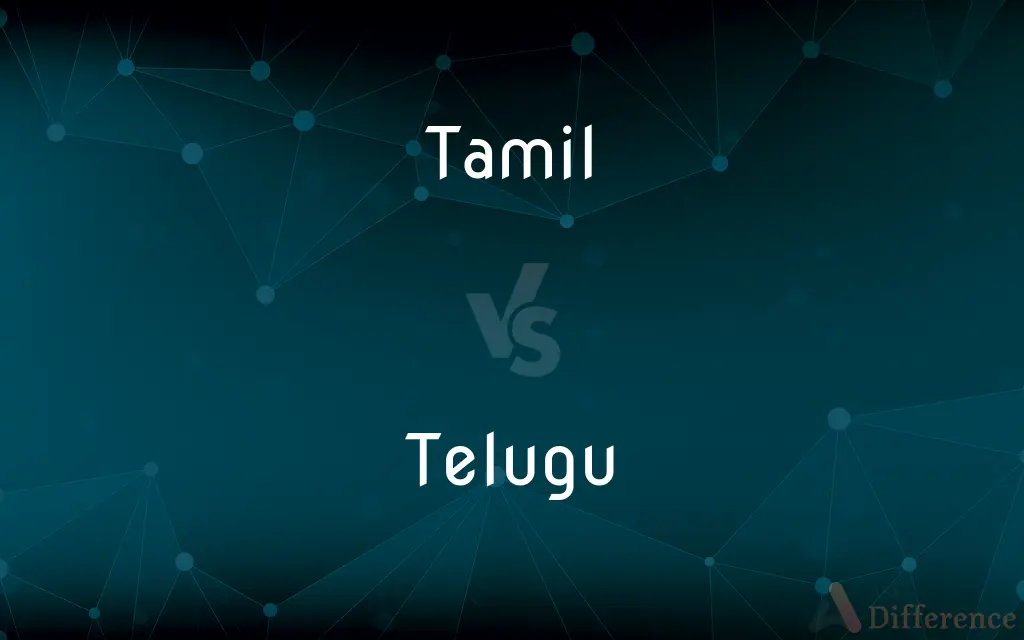Tamil vs. Telugu — What's the Difference?
By Tayyaba Rehman & Fiza Rafique — Updated on March 24, 2024
Tamil is a Dravidian language spoken primarily in Tamil Nadu, India, and Sri Lanka, while Telugu is spoken in the states of Andhra Pradesh and Telangana, India.

Difference Between Tamil and Telugu
Table of Contents
ADVERTISEMENT
Key Differences
Tamil, one of the oldest living languages, has a rich literary tradition dating back over 2,000 years, emphasizing classical literature and poetry. Telugu, known as the "Italian of the East" for its mellifluous nature, also boasts a significant literary history but is younger compared to Tamil, with its literature emerging around the 11th century.
The script used for Tamil has distinct characters with rounded shapes due to the writing tools traditionally used on palm leaves, which would tear if straight lines were used. Telugu script, while also derived from the Brahmi script like Tamil, features a range of curves and loops, giving it a visually intricate appearance.
Phonetically, Tamil has a more conservative sound system, maintaining older Dravidian phonetic elements. It lacks aspirated consonants found in many other Indian languages. Telugu, conversely, incorporates a blend of aspirated and unaspirated sounds, making its phonology more complex compared to Tamil.
Grammatically, both languages exhibit the agglutinative nature of Dravidian languages, where suffixes are added to a base word to convey tense, case, mood, and other grammatical features. However, Tamil grammar is noted for its purity and has remained less influenced by Sanskrit compared to Telugu, which has integrated many Sanskrit words and grammatical elements.
In terms of geographical spread and usage, Tamil has a significant international presence, with large diaspora communities across the globe, including Malaysia, Singapore, and the Gulf countries. Telugu, while predominantly spoken in India, also has a considerable international diaspora, especially in the United States, where it is among the fastest-growing languages.
ADVERTISEMENT
Comparison Chart
Age and Literature
Over 2,000 years old with ancient literature
Literature from around the 11th century
Script
Rounded characters due to palm leaf manuscripts
Curves and loops, visually intricate
Phonology
Conservative, lacks aspirated consonants
Includes both aspirated and unaspirated sounds
Grammar
Agglutinative, less Sanskrit influence
Agglutinative, more Sanskrit influence
International Presence
Significant, with large diaspora
Considerable diaspora, especially in the US
Compare with Definitions
Tamil
Rich in classical literature and poetry.
The Sangam literature in Tamil encompasses some of the oldest extant poems in India.
Telugu
Rich literary tradition starting from the 11th century.
Early Telugu literature includes works like the Mahabharata by Nannaya.
Tamil
An ancient Dravidian language.
Tamil literature, known for its antiquity, provides a window into early South Indian culture.
Telugu
A Dravidian language with mellifluous phonetics.
Telugu's melodious nature has earned it the title Italian of the East.
Tamil
Spoken predominantly in Tamil Nadu and Sri Lanka.
Tamil is an official language in Tamil Nadu, India, and Sri Lanka.
Telugu
Incorporates Sanskrit elements in grammar and vocabulary.
Telugu has absorbed many Sanskrit words, enriching its lexicon.
Tamil
Uses a unique script.
The Tamil script is characterized by its rounded letters, adapted for writing on palm leaves.
Telugu
Features a visually intricate script.
The Telugu script, with its range of curves and loops, is known for its aesthetic appeal.
Tamil
Maintains a conservative phonetic system.
Tamil's phonology is notable for its absence of aspirated consonants.
Telugu
Predominantly spoken in Andhra Pradesh and Telangana, India.
Telugu is the official language of Andhra Pradesh and Telangana.
Tamil
A member of a Dravidian people of southern India and northern Sri Lanka.
Telugu
A Dravidian language spoken in central India.
Tamil
The Dravidian language of the Tamil.
Telugu
A member of the Dravidian people who speak Telugu.
Tamil
Of or relating to the Tamil or their language or culture.
Telugu
Of or relating to Telugu, its speakers, or their culture.
Tamil
Of or pertaining to the Tamils, or to their language.
Telugu
A Darvidian language spoken in the northern parts of the Madras presidency. In extent of use it is the next language after Hindustani (in its various forms) and Bengali.
Tamil
One of a Dravidian race of men native of Northern Ceylon and Southern India.
Telugu
One of the people speaking the Telugu language.
Tamil
A member of the mixed Dravidian and Caucasoid people of southern India and Sri Lanka
Telugu
Of or pertaining to the Telugu language, or the Telugus.
Tamil
The Dravidian language spoken since prehistoric times by the Tamil people in southern India and Sri Lanka
Telugu
A member of the people in southeastern India (Andhra Pradesh) who speak the Telugu language
Tamil
Of or relating to a speaker of the Tamil language or the language itself;
The Tamil Tigers are fighting the Sinhalese in Sri Lanka
Tamil agglutinative phrases
Telugu
A Dravidian language spoken by the Telugu people in southeastern India
Common Curiosities
What is the Tamil language?
Tamil is an ancient Dravidian language with a rich literary tradition, spoken primarily in Tamil Nadu, India, and Sri Lanka.
How has Sanskrit influenced Tamil and Telugu?
Tamil has remained less influenced by Sanskrit, retaining its grammatical purity, whereas Telugu has integrated many Sanskrit words and grammatical rules.
Can you compare the literary traditions of Tamil and Telugu?
Tamil's literary tradition is ancient, dating back over 2,000 years, focusing on classical literature and poetry. Telugu's literary history, starting around the 11th century, is also significant but younger than Tamil's.
What makes Tamil phonology unique compared to Telugu?
Tamil maintains a more conservative phonetic system, lacking aspirated consonants, unlike Telugu, which includes both aspirated and unaspirated sounds.
How do Tamil and Telugu differ in their phonetic systems?
Tamil has a conservative phonetic system without aspirated consonants, while Telugu's phonetic system includes a mix of aspirated and unaspirated sounds.
What is the Telugu language?
Telugu is a Dravidian language known for its mellifluous sound, spoken mainly in Andhra Pradesh and Telangana, India.
How do the scripts of Tamil and Telugu differ?
Tamil script consists of rounded characters, suitable for writing on palm leaves, while Telugu script is characterized by its intricate curves and loops.
Are Tamil and Telugu mutually intelligible?
Despite both being Dravidian languages, Tamil and Telugu are not mutually intelligible due to significant differences in phonology, syntax, and vocabulary.
How are Tamil and Telugu grammatically similar?
Both languages are agglutinative, adding suffixes to base words to express grammatical relationships, though Tamil is less influenced by Sanskrit compared to Telugu.
What are some key cultural aspects of Tamil?
Tamil culture is known for its ancient literature, classical arts, and deep historical roots in South Indian history.
What are the official statuses of Tamil and Telugu?
Tamil is an official language in Tamil Nadu, India, and Sri Lanka. Telugu is the official language of Andhra Pradesh and Telangana, India.
What is the global presence of Tamil and Telugu?
Both languages have international diasporas, with Tamil having a significant presence in countries like Malaysia and Singapore, and Telugu having a considerable presence, especially in the United States.
What are some key cultural aspects of Telugu?
Telugu culture is celebrated for its literature, music, and cinema, contributing significantly to the cultural tapestry of South India.
What role does literature play in Tamil and Telugu societies?
Literature plays a central role in both Tamil and Telugu societies, reflecting their historical, cultural, and social values.
Share Your Discovery

Previous Comparison
Rely vs. Trust
Next Comparison
Pretty vs. AttractiveAuthor Spotlight
Written by
Tayyaba RehmanTayyaba Rehman is a distinguished writer, currently serving as a primary contributor to askdifference.com. As a researcher in semantics and etymology, Tayyaba's passion for the complexity of languages and their distinctions has found a perfect home on the platform. Tayyaba delves into the intricacies of language, distinguishing between commonly confused words and phrases, thereby providing clarity for readers worldwide.
Co-written by
Fiza RafiqueFiza Rafique is a skilled content writer at AskDifference.com, where she meticulously refines and enhances written pieces. Drawing from her vast editorial expertise, Fiza ensures clarity, accuracy, and precision in every article. Passionate about language, she continually seeks to elevate the quality of content for readers worldwide.














































